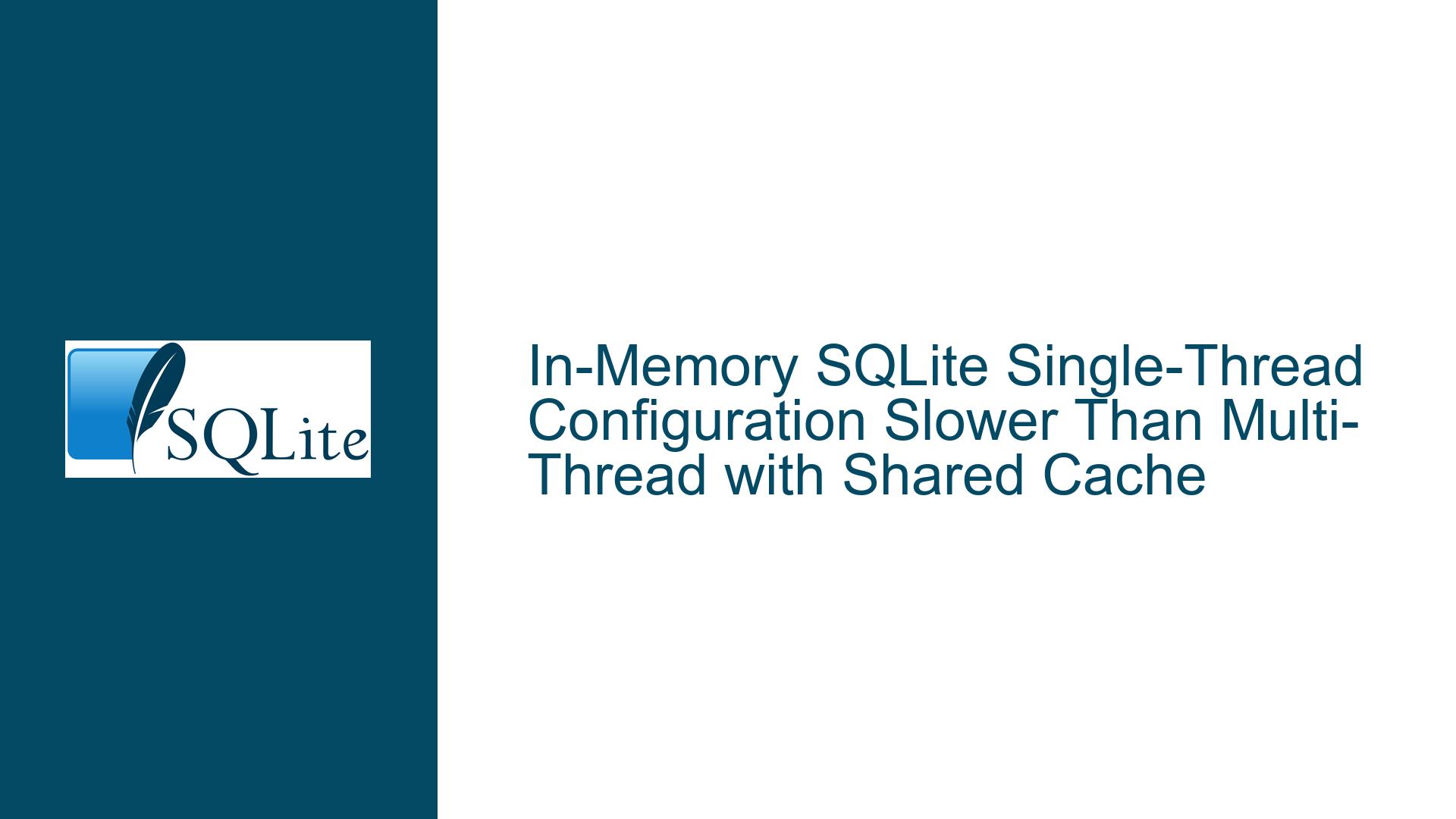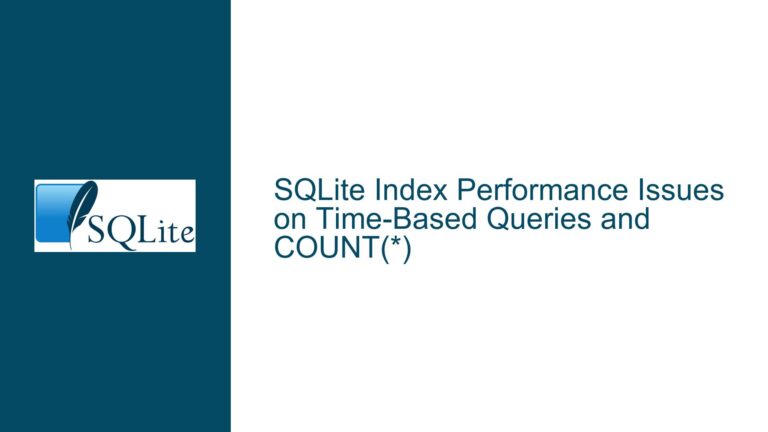In-Memory SQLite Single-Thread Configuration Slower Than Multi-Thread with Shared Cache
Understanding Performance Discrepancies Between Single-Thread and Multi-Thread SQLite Modes
This guide addresses a common misconception about SQLite threading modes and in-memory database performance. A developer observed that a multi-threaded configuration with shared cache (SQLITE_OPEN_SHAREDCACHE) achieved 1 ms per insert, while a setup with four threads using separate in-memory databases in single-thread mode (SQLITE_CONFIG_SINGLETHREAD) suffered 10–20 ms per insert. The root cause involves SQLite’s threading model, resource contention, and benchmarking methodology.
Core Misconfigurations and Invalid Assumptions
1. Threading Mode vs. Connection Concurrency
- Single-Thread Mode (
SQLITE_CONFIG_SINGLETHREAD): This configures SQLite’s global threading model to disallow internal mutexes. It does not mean "one thread per database." Once set, all database connections in the process must be accessed from a single thread. Using multiple threads to access SQLite in this mode violates thread safety, causing undefined behavior (e.g., crashes, data corruption, or artificial serialization delays). - Shared Cache Mode (
SQLITE_OPEN_SHAREDCACHE): Allows multiple connections in the same thread to share a common page cache. While it can reduce memory usage, it introduces coarse-grained locks, often leading to contention. Despite being discouraged, it may appear faster in flawed benchmarks due to reducedmalloc()overhead or cache locality.
2. In-Memory Database Isolation
- Opening
":memory:"databases withSQLITE_OPEN_PRIVATECACHE(default) creates isolated databases. Even with four threads, each has its own schema, data, and cache. This eliminates contention but prevents resource pooling. However, if the OS or SQLite serializes access to global structures (e.g., the heap), throughput degrades.
3. Measurement Methodology Flaws
- Wall-Clock Time vs. CPU Time: Measuring individual inserts with millisecond precision on systems with preemptive multitasking (e.g., Windows, Linux) is unreliable. A 1 ms measurement might span multiple scheduler quanta (e.g., 15 ms on Windows).
- Autocommit Overhead: Each
INSERTwithout an explicit transaction wraps the operation in a transaction. For 10,000 inserts, this means 10,000 fsync-equivalent operations (even for in-memory databases), which serializes I/O.
4. SQLite Internals and Contention
- Memory Allocation: SQLite uses
sqlite3_malloc()for temporary structures. In single-thread mode, the heap is unprotected, forcing concurrent threads to contend for the OS’s memory allocator locks (e.g.,ptmallocon Linux). - Schema Locking: Operations like preparing statements acquire the schema lock. In single-thread mode, this lock is bypassed, but concurrent access from multiple threads corrupts internal state.
Diagnosing and Resolving the Performance Degradation
Step 1: Validate Threading Configuration
- Remove
SQLITE_CONFIG_SINGLETHREAD: This mode is incompatible with multi-threaded applications. UseSQLITE_OPEN_NOMUTEXorSQLITE_OPEN_FULLMUTEXper-connection instead. - Use Multi-Thread Mode:
sqlite3_config(SQLITE_CONFIG_MULTITHREAD); sqlite3_initialize(); // Open connections with SQLITE_OPEN_NOMUTEX (if threadsafe) - Isolate In-Memory Databases: Ensure each
":memory:"connection usesSQLITE_OPEN_PRIVATECACHE.
Step 2: Optimize Transactions and Queries
- Batch Inserts with Explicit Transactions:
sqlite3_exec(db, "BEGIN", 0, 0, 0); for (int i = 0; i < N; i++) { // Execute inserts } sqlite3_exec(db, "COMMIT", 0, 0, 0);Reduces transaction overhead from O(N) to O(1).
- Reuse Prepared Statements:
sqlite3_stmt *stmt; sqlite3_prepare_v2(db, "INSERT INTO t VALUES (?)", -1, &stmt, 0); for (int i = 0; i < N; i++) { sqlite3_bind_int(stmt, 1, i); sqlite3_step(stmt); sqlite3_reset(stmt); } sqlite3_finalize(stmt); - Avoid Dynamic SQL Generation: The test code spends cycles generating
REPLACEstatements with random strings. Precompute or bind parameters.
Step 3: Profile and Isolate Bottlenecks
- Use SQLite’s Profiling Functions:
sqlite3_profile(db, [](void*, const char* sql, sqlite3_uint64 ns) { printf("Query: %s\nTime: %f ms\n", sql, ns / 1e6); return 0; }, 0); - Check for Memory Allocator Contention:
Replace the default allocator with a thread-friendly alternative (e.g.,jemalloc,tcmalloc).
Step 4: Validate Shared Cache Implications
- Avoid
SQLITE_OPEN_SHAREDCACHE: It’s deprecated for most use cases. If shared data is required, use a disk-based database with WAL mode. - Benchmark Disk vs. Memory: In-memory databases are not always faster due to missing optimizations like memory-mapped I/O.
Step 5: Analyze System-Level Interactions
- CPU Affinity: Pin threads to cores to reduce cache thrashing.
- Avoid Hyper-Threading: Physical cores often provide more predictable performance.
Permanent Fixes and Best Practices
Threading Model:
- Use
SQLITE_CONFIG_MULTITHREADfor multi-threaded apps. - Open connections with
SQLITE_OPEN_NOMUTEXif each connection is confined to one thread.
- Use
Memory Configuration:
- Preallocate a page cache pool:
void* cache = malloc(SQLITE_DEFAULT_CACHE_SIZE); sqlite3_config(SQLITE_CONFIG_PAGECACHE, cache, SQLITE_DEFAULT_PAGE_SIZE, 1000);Schema Design:
- Use
INTEGER PRIMARY KEYfor rowid aliasing. - Avoid excessive indexes on frequently updated tables.
- Use
Connection Pooling:
- Reuse connections instead of opening/closing per operation.
Monitoring:
- Enable
SQLITE_ENABLE_STAT4for better query planning. - Periodically
ANALYZEthe database.
- Enable
By addressing configuration errors, eliminating transaction overhead, and isolating thread interactions, the performance of single-threaded in-memory databases can meet or exceed shared-cache configurations. Always validate assumptions with SQLite’s profiling tools and real-world workloads.






